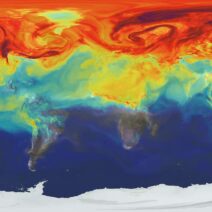In recent years, the dialogue surrounding climate change has intensified, revealing a myriad of viewpoints and nuanced debates. One of the primary discussions encompasses the correlation between solar activity and global warming. Could fluctuations in solar output be the dominant driver of our planet’s climate variations? Or are human activities—the burning of fossil fuels and deforestation—fundamentally shifting the Earth’s climate? To dissect this complex interplay, one must delve into the intricate workings of solar phenomena and anthropogenic influences.
Solar activity, characterized primarily by sunspots, solar flares, and solar irradiance, possesses a significant influence on Earth’s climate. The Sun, our nearest star, undergoes cyclical phases, typically spanning around eleven years, known as the solar cycle. During periods of heightened sunspot activity, solar irradiance increases slightly, potentially affecting global temperatures. However, how substantial is this effect in comparison to the factors driven by human activity?
Engaging with this question necessitates an examination of paleoclimate data. Historical records indicate that Earth’s climate has experienced considerable shifts over millennia, influenced by various natural factors, including volcanic eruptions, ocean currents, and, indeed, variations in solar output. Yet, anthropogenic influences emerged rapidly in the past few centuries, particularly in the wake of the Industrial Revolution. The correlation between rising greenhouse gas concentrations—chiefly carbon dioxide and methane—and increased global temperatures has been documented. Contemporary climate models overwhelmingly suggest that these human-induced factors far outweigh the effects of solar variability.
Let us consider the documented relationship between solar activity and temperature changes during the 20th century. Research indicates that while solar output did experience a gradual uptick between 1900 and the late 1950s, corresponding increases in temperature were also observed. However, as solar activity plateaued post-1960, global temperatures continued to rise sharply as greenhouse gas emissions surged. This divergence offers compelling evidence that solar changes alone cannot account for the dramatic warming trends recorded in recent decades.
In discussing this contentious issue, it is crucial to recognize the role of climate feedback mechanisms. For instance, as the Earth warms due to greenhouse gases, feedback loops involving water vapor and ice melt come into play, amplifying the initial warming. This phenomenon is particularly important when evaluating predictions of future climate scenarios. It indicates that even marginal increases in solar output could have amplified effects under a warming climate.
Moreover, the scientific consensus has become increasingly evident. Institutions like NASA, the National Oceanic and Atmospheric Administration (NOAA), and the Intergovernmental Panel on Climate Change (IPCC) emphasize that the primary driver of recent climate change is human activity. While the Sun undeniably influences the Earth’s climate, the present trajectory of warming cannot be divorced from anthropogenic factors.
However, it is equally important to scrutinize the critiques of this conventional perspective. Detractors often highlight instances where solar activity appears to correlate with climatic changes. They argue that this relationship warrants further exploration and should not be dismissed as negligible. The challenge is thus not the absence of scholarly inquiry into solar impacts, but rather the necessity to contextualize these findings within the broader framework of climate science.
Next, it would be prudent to address the implications of accepting solar activity as a significant factor in climate change. If popular discourse veers towards attributing climate trends solely to solar variability, it could undermine the urgency of dealing with human-induced climate change. This potential misrepresentation poses a challenge: How can we effectively communicate the nuanced complexities of climate science to a public seeking clear answers?
As one navigates through these discussions, it becomes evident that oversimplification serves neither the scientific community nor policy-making efforts aimed at mitigating climate change. An understanding of solar and anthropogenic factors can be complementary, rather than mutually exclusive. To this end, continued research into solar influences should remain a vital component of climate science, contributing to a more holistic understanding of Earth’s climate system.
Looking ahead, interdisciplinary approaches that amalgamate solar physics, climate modeling, and environmental sciences will be paramount in disambiguating this intricate nexus of influences. By fostering collaboration among scientists across quantitative and qualitative disciplines, the pathways to innovative solutions emerge clearer—opening avenues for addressing climate change’s myriad challenges.
In conclusion, while solar activity undoubtedly plays a role in the Earth’s climatic dance, it is unequivocally overshadowed by the profound imprint of human activity. The burgeoning body of evidence supports the assertion that the rapid alterations in our planet’s climate are predominantly anthropogenic. Nevertheless, curiosity about the Sun’s role remains valid and essential. As we confront the existential threat posed by climate change, the imperative is not to dismiss alternative perspectives, but to embrace a comprehensive approach that fosters informed discussions and sustainable solutions.








